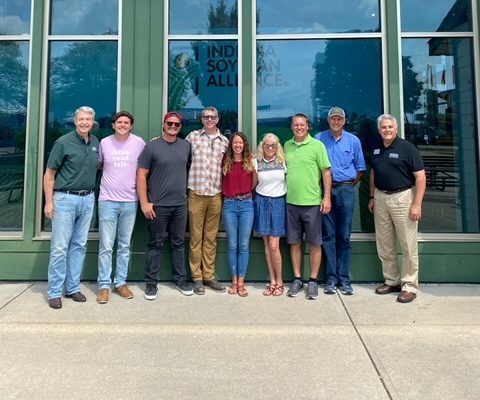BY KEN THOMPSON
PHOTOS PROVIDED
Growing up on a farm in Fowler, Indiana, Johnny Klemme developed a passion for the Big Pine Creek.
“The Big Pine was kind of my stomping grounds as a kid,” says Klemme, who enjoyed fishing, canoeing and kayaking.
Now in his career as a Warren County-based land advisor and broker, Klemme is doing his part to make the Big Pine Creek Watershed an example of how teamwork between farmers, landowners and other stakeholders can combine profit with preservation of the natural environment.
“I’m really passionate about making sure these natural resources, particularly our soil and ecosystems of this creek, are taken care of so the next generation can enjoy them like we had the opportunity to do,” Klemme says.
Spanning 209,000 acres across Benton, Tippecanoe, Warren and White counties, the Big Pine Creek Watershed is fulfilling its mission to voluntarily conserve and improve the natural environment while balancing the interests of those living within its boundaries.
“One of the big goals of this project is ensuring these farms remain profitable while making these types of conservation changes,” Klemme says. “If we can’t ensure the farmers remain profitable, then it all falls apart.”
“We have seen that farms and generational farms specifically are some of our best stewards of our farmland. We are able to demonstrate that profitability can be there while also improving the water quality downstream.”
Big Pine recently earned a 2022 Governor’s Award for Environmental Excellence from the state of Indiana. Big Pine was recognized in the land use/conservation category.
“The Big Pine Creek Watershed Project is a water-quality improvement program focused on preventing nutrient and sedimentary run off,” the citation states. “In addition to implementing practices like cover crops, other goals include educating farmers and landowners on the impact they have on the watershed, as well as raising funds to support this work.
“Since the program’s inception (in 2014), it has prevented over 110,000 tons of sediment from entering local waterways, hosted 6,500 participants at area events, reached 30 percent of watershed residents regarding the importance of water quality in the watershed and raised over $6 million to accomplish this work.”
The Big Pine Creek empties directly into the Wabash River upstream of Attica, the next step in a waterway journey that traverses the Ohio and Mississippi rivers before reaching the Gulf of Mexico.
Educating others to think about that big picture has been Leslie Fisher’s job since 2016. Fisher was hired as coordinator of the Big Pine Creek Watershed project by the Benton County Soil and Water Conservation District.
Fisher’s background of working with Purdue Extension-Benton County and local farmers, along with experience in resource management, made this job a natural fit for her skills.
“As of last year, the efforts of our farmers and landowners have prevented 289,478 pounds of nitrogen, 145,654 pounds of phosphorous and 110, 454 tons of sediment from entering waterways,” Fisher says.

Reducing nitrogen and phosphorous in our water helps minimize damage to aquatic plants, fish and lake organisms. Too much of both elements in water can result in overgrowth of free-floating plants that can block oxygen and sunlight needed for survival.
Excess sediment depletes the oxygen supply and can lead to killing fish.
In sports terminology, Fisher is the coach bringing together players with many different interests in order to achieve a common goal.
“The community needs to know that this project is possible through the efforts of 40-plus partnerships from several different types of organizations that would not typically work together,” Fisher says. “And that it’s only been successful due to those relationships and the commitment from our local landowners and farmers to become better stewards of their land.”
Major corporate conservation initiatives were formed with local co-op Ceres Solutions, Land O’Lakes, Coca-Cola and Tate & Lyle, plus other Indiana-based companies.
Complicating the mission is the fact that contrary to public belief, Indiana is not a flat-land state.
The northern and western regions of the watershed once upon a time were prairie, while woodlands covered the southern and eastern regions.
“Big Pine is one of those places where you’ve got this unique blend of very productive farmland that also feeds a major creek that has rare flora and fauna species on it,” Klemme says. “You’ve got smaller farms and more rolling wooded areas in the southern part of the watershed. As you get up in the northern parts of the watershed, those are all former prairies and former wetlands. It’s 90-plus percent row crop agriculture.
“The way we like to say it, there’s no better place to work on a giant case study of how we could implement conservation practices and have a positive effect on water quality than this particular watershed.”
The success story of Big Pine Watershed has been profiled in a 20-minute documentary, “Land – Values,” directed by Klemme with the aid of a small grant from Indiana Humanities. It premiered for online streaming Dec. 9.
“We’re just really fortunate that here in Benton, Tippecanoe, Warren and White counties we do have some of the most productive farmland in the Midwest,” Klemme says. “Our area is being looked at and seen across the country as a leader in these type of practices, as well as a leader in technology, sensors and equipment that are being tested, developed and manufactured in the greater 10-county region through organizations such as the Wabash Heartland Innovation Network.”
Funding for the Big Pine Creek Watershed project has been extended through 2027.
There’s much more that can be done during these next few years, Fisher says.
“If (you) farm or own land, I would highly encourage you to reach out to your local USDA Service Center to discuss potential options on your land,” Fisher says. “There are all kinds of conservation practices that can make a huge difference both environmentally, but also economically.
“These could include planting cover crops in between the cash crop, reducing tillage, soil health testing and nutrient management plans and even adding pollinator strips on field borders. These conservation practices can solve many natural resource concerns such as erosion, improving soil health and improving water quality. They also can add some major value to the land.” ★


